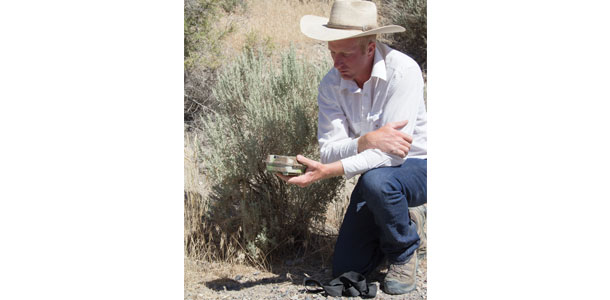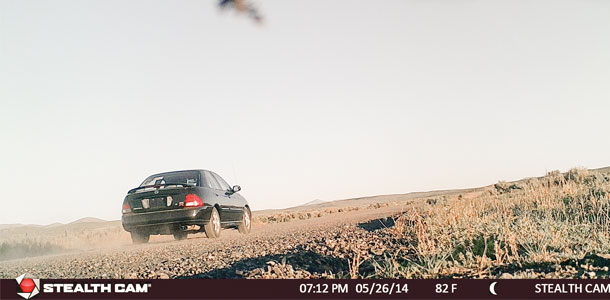However, it takes more than good aim and a steady hand on the shooting range to qualify. One steady assignment, for instance, was to record and report battlefield information.
They worked mostly in two-man or three-man teams, trying to blend in and moving about the countryside quietly to ascertain enemy movement and identify artillery caches. Every mission depended on cover and concealment – the basic elements of camouflage.
After completion of the tour, Boies returned to Nevada and completed a criminal justice degree at University of Nevada – Reno, then later returned to the ranch in the arid mountain desert.
In northeastern Nevada, there are no small ranches. The sheer vastness of the rangeland makes it difficult for limited law-enforcement resources to provide a constant level of security. The same remote factor provides enticement for criminal activity – hay theft, cattle rustling and equipment theft or destruction.
Having experienced some of these losses, Boies drew on his proficiency with military scouting and criminal justice to provide broader security for his own ranch through a system of strategically placed, carefully camouflaged, motion-activated game cameras.
“The initial concern arose from the high price of cattle and the additional cost of vandalism to our properties,” says Boies. “We approached the challenge as an owner-operator responsibility. I approached this as much as a preventative or deterrent project as anything. I think that it is important if this will deter criminal action. We’re not looking to just get people in trouble.”
Boies says that although he and neighboring ranches individually added security components to their operations, the county sheriff’s office was more than willing to provide assistance.
Lt. Marvin Morton of the Elko County Sheriff’s Department and a 23-year veteran of law enforcement works with ranchers experiencing thefts in northeastern Nevada. He deploys six to eight cameras at a time and receives pictures on his phone or computer whenever the camera is activated.
“Over the last few years, we’ve had one rancher down 300 head,” Morton says. “They’re not just taking five head here and three head there; they’re loading up probably 30 head at a time in pretty tight quarters and loading them in stock trailers.” And, Morton adds, if you steal a cow it’s a felony. If you take 30 calves, it’s 30 felonies.
Morton says they’ve used the motion cameras for the last five or six years and have been successful prosecuting some cases of hay theft.
Part of the success with the system, he says, is that it’s really easy to get good photos and capture faces in the photos even at night with the infrared rays. “Face shots help with the prosecution. It’s hard for a person when you get their plate, their vehicle and their picture to try and get out of that.”
At the very least, if landowners know who’s coming and going, then if there is a problem, the images let ranchers know where to start looking for answers. It can provide valuable information to landowners and law enforcement.
Do laws restrict camera placement? Morton says yes. If a rancher puts the cameras on the private property of a neighboring ranch (which might lead into his property, for instance), he has to get permission from the owner.
Morton also works with Bureau of Land Management, U.S. Forest Service and Nevada Department of Wildlife personnel to obtain permission when placing cameras on government-owned properties.

The equipment
Game cameras are readily available from sportsmen’s supply stores or online and are relatively inexpensive compared to the price of losing one head of cattle or having a ranch improvement compromised.
For less than $500, Boies claims four cameras properly placed can cover nearly 50,000 acres. The key is placement and camouflage.
Less expensive cameras typically come in separate units – a camera (housed in a metal or plastic box of some sort) and a viewer (which typically looks like a handheld, household camera). A compatible SD memory card easily transfers from the camera unit to the viewer unit.

Steps for success
Boies outlines several steps to install and maintain a successful security system:
- Clearly define the objective, which is to identify the threat by gathering information.
- Camouflage the units for placement. Many game cameras come already camouflaged, but even the black-box variety can be camouflaged with paints for concealment.
Boies believes that pre-camouflaged cameras work better because do-it-yourself projects often create a darker shadow than normal, subtly calling attention to the camera.
- Read the owner’s manual. The camera will have various adjustments, such as power switches, testing, time out, date, GPS capability, security codes, etc. These will have to be set by the purchaser. You’ll need to understand the SD memory card and how to use it with the accompanying viewer. You’ll also need a supply of lithium batteries.
- Identify the best information-gathering points. These typically include access points to the property. In Nevada, this usually consists of dirt roads that off-shoot from the main highway or adjoining properties.
- Determine the camera location. The camera doesn’t need to be next to the asset needing protection. For instance, it doesn’t need to be near a water tank, corral, near unbranded calves or at a cattle guard. If there are four in-roads to the property or choke-points through which traffic must funnel, a camera along any point on those roads will achieve the objective of identifying the threat.
And it’s much more difficult for intruders to identify one sagebrush where a camera may be hiding among hundreds of thousands, as opposed to half a dozen cattle guards or watering troughs.
- Determine the best angle for the camera view. The angle should allow for plenty of time to detect the motion and subsequently snap the pictures. This is a trial-and-error process. Place the camera angle, then test it out by driving past the camera at different speeds to see if the camera is capturing what you intended.
- Conceal the camera. Secure it in the shadows (to prevent glare) of a sagebrush, log, tree, rock or other natural feature. Some come with a strap or other attachment mechanism, but even a zip-tie will work.
The camera needs a clear, unobstructed line of sight. Any waving grass blade or plant can trigger the motion sensor, so these will need to be cleared from view. More brush or forbs can be added around the camera for additional concealment and to break up the outline.
- Return and check the cameras periodically to make sure they’re still concealed and secure, and also to check the images (at least for the basic models). The SD memory card from the camera can be easily slipped into the viewer.
From the viewer, the operator can either delete the images or download them to be stored directly into the viewer for transport to a laptop. The memory card is then placed back into the camera again, ready for action.
Morton says security cameras will also help ensure successful hunting seasons for the majority of sportsmen. He says there are several ranchers who are very generous and grant hunting permission, but a few have had to close off their properties to all hunters because of the criminal actions Morton thinks is limited to only a handful of individuals.
Morton noted most hunters are asking permission, hunting only in season, closing gates behind them and are respectful of property; in that regard, most sportsmen don’t have to worry if their actions are being recorded. However, a few seem to spoil it for the majority, and if those few individuals can be stopped, the hunting majority will benefit.
There are differing thoughts regarding whether a rancher should post signs informing people that the property is monitored. One thought is to keep it quiet, as a rancher might be looking closer to home for the culprits – an employee, maybe, who knows the habits and schedules of owners and other ranch hands.
Boies’ approach was more as a deterrent. Boies says, “It may be a good thing if people are out there doing something wrong to know that they could be caught at any time. At the very least, it’ll give ’em a lot of stressful nights. It shouldn’t be easy to be a criminal.” ![]()
PHOTOS
PHOTO 1: Game cameras are becoming popular with cattlemen as cattle and equipment thefts and vandalism rates rise. Key locations for placement include vehicle access points to the property.
PHOTO 2: Nathan Boies uses principles of cover and concealment to position cameras within sagebrush stands.
PHOTO 3: To see a video of Boies’ steps for placement and concealment click on this site. Photos courtesy of Nathan Boies and Lynn Jaynes.







